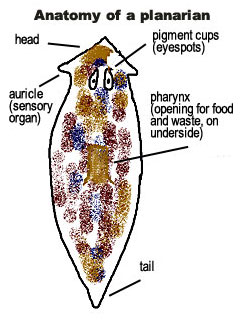Planaria: A window on regeneration
Many people make their acquaintance with a planaria and its regenerative capacities when they cut one up in biology class. Planaria are tiny flatworms that live in freshwater and marine environments, and on plants throughout the globe. A single one can be cut into hundreds of pieces and each will grow back into a whole planarian—a remarkable feat.
Planarians (and other bi-directionally regenerating animals) can use this capability to reproduce asexually, and, in effect, clone themselves. Because of this remarkable ability, one planarian and its genome can be created over and over, giving it a sort of immortality. Just how old is the oldest planaria? No one really knows.
Scientists have recently learned that planaria are full of cells similar to stem cells. These cells are ready at any time to transform into whichever specific type of cell a planaria needs in order to regenerate lost tissue. The ability of these cells to become whatever tissue the body needs is very similar to the capacity of embryonic stem cells in humans and other vertebrates. This similarity makes planaria very interesting to scientists, and their simple bodies and few tissue types make them relatively easy to study. Interestingly, the planarian’s stem-cell-like cells are distributed throughout their bodies in great numbers, which helps lend them their amazing rengenerative qualities.






 Any way you slice it
Any way you slice it
Planarian regeneration stands out for its dramatic scope, its rapid pace, and the mechanisms that make it possible. And not only can the pieces of a sliced-up planarian each grow into a new flatworm, but regeneration happens quickly: It only takes a week or two for each piece to turn into a miniature version of the original flatworm.
Planaria can also work a sort of magic trick while regenerating: Imagine you’re nothing but a tail trying to regrow a head. How will you eat? Or what if you’re a head with no gut to digest things? The answer is that planaria feed off themselves . As a head grows back, for example, cells in the tail end will self-destruct and provide the regenerating animal with the energy needed to survive. Over time, the tail portion will shrink—to a proportion that exactly matches that of the head it's regenerating. Once it’s whole again, it will begin to feed and grow back to a normal size. How it manages to do this proportion-readjustment trick is one of the questions researchers are trying to answer.
Next: How do they do it? »
Planarians (and other bi-directionally regenerating animals) can use this capability to reproduce asexually, and, in effect, clone themselves. Because of this remarkable ability, one planarian and its genome can be created over and over, giving it a sort of immortality. Just how old is the oldest planaria? No one really knows.
Scientists have recently learned that planaria are full of cells similar to stem cells. These cells are ready at any time to transform into whichever specific type of cell a planaria needs in order to regenerate lost tissue. The ability of these cells to become whatever tissue the body needs is very similar to the capacity of embryonic stem cells in humans and other vertebrates. This similarity makes planaria very interesting to scientists, and their simple bodies and few tissue types make them relatively easy to study. Interestingly, the planarian’s stem-cell-like cells are distributed throughout their bodies in great numbers, which helps lend them their amazing rengenerative qualities.





Knowing a few planarian body parts (there aren’t that many to begin with) will help you better see what’s growing back. The first feature you’re likely to notice is the
pigment cups
that make planaria cartoonishly cute. These spots contain photoreceptors that sense light, and function as the animal’s rudimentary “eyes.” In most species, the sides of the head also have points known as
auricles
that serve as organs of smell and touch. In its midsection, a planaria has a
pharynx
, a sort of all-purpose feeding and excreting tube. The tail end is usually slightly pointed. Knowing which of these parts is missing from a planarian tells you which ones you’ll see growing back.
Planarian regeneration stands out for its dramatic scope, its rapid pace, and the mechanisms that make it possible. And not only can the pieces of a sliced-up planarian each grow into a new flatworm, but regeneration happens quickly: It only takes a week or two for each piece to turn into a miniature version of the original flatworm.
Planaria can also work a sort of magic trick while regenerating: Imagine you’re nothing but a tail trying to regrow a head. How will you eat? Or what if you’re a head with no gut to digest things? The answer is that planaria feed off themselves . As a head grows back, for example, cells in the tail end will self-destruct and provide the regenerating animal with the energy needed to survive. Over time, the tail portion will shrink—to a proportion that exactly matches that of the head it's regenerating. Once it’s whole again, it will begin to feed and grow back to a normal size. How it manages to do this proportion-readjustment trick is one of the questions researchers are trying to answer.
Next: How do they do it? »


